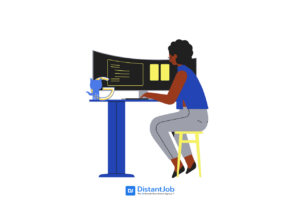The puritan digital nomad will argue it can look like anything as long as you have a laptop and an internet connection. But remote work is growing at such a rate that parks and cafés aren’t enough to accommodate it. A good home-office setup is necessary.
Employers who see the benefits of remote work have made it into a deciding factor about whether to hire someone. Alex Turnbull, the founder of Groove—for example—asks prospective employees about their home-office setup during their interview process.
An experienced remote worker will have a dedicated workspace with the tools they need to work.
For more help finding the pro remote worker contact us. Otherwise, take a look at why your remote team member needs a functional home office.
Why it’s important to have a good remote workspace
Even if remote workers swing between cafés and coworking spaces, their home office is their base.
To employers, a home office can be a clear signal of whether someone is ready to work remotely.
Why should your remote employee have a home office?
- It shows they have the means and scope to work from home.
- A dedicated office area will help them switch from “home-mode” to “office mode”.
- For a prospective employee, a home workspace shows they’re up to the challenges of remote work – like overcoming home-related distractions.
- Adds permanence to their work routine – and enables them to be more professional.
- Signals to others at home that they are working and not available.
- A dedicated space means they don’t have to spend time setting up every time – as they do in a co-work space.
- They can make the space conducive to their work – customize it according to their needs, which in turn will help productivity.
- They don’t have to go outside, so no excuses like “snow-day.”
What makes a functional remote workspace?
Transitioning from home-mode to office-mode is a big deal for anyone working from home.
Only a lucky few have an extra room they can turn into a study. So choosing the location of the work area becomes even fiddlier.
The ideal situation is a quiet, distraction-free space somewhere in the house – no reminder of the comfy couch a few feet away or the dishwasher that needs emptying.
Other than the location, the setup can be as straightforward or as tricked out as anyone likes.
Some essentials include:
- Adjustable and ergonomic desk and chair
- Laptop – not just a notebook
- Unfailing internet connection – maybe with a high-speed router
- Mouse, keyboard, screen – these aren’t essential, but useful for developers
- Speakers, mic, noise-canceling headphones
- Good lighting – natural light and table lamp
- Stationaries and means for analog thinking, like whiteboard/painted chalkboard
- Chargers for smartphones and other devices, power banks, and surge protector
- External hard drive – the digital worker’s filing cabinet
- Extras: coffeemaker, “just-do-it” style posters, squishy anti-stress balls, pics of their doggies, and anything else that helps them hunker down to work
What happens if a prospective employee’s remote home office is wanting?
What happens if you realize that a remote work tool is missing from your prospective employees’ arsenal? Depends on how important the missing element is.
An essential missing piece should raise a red flag during the interview process.
If a developer has a notebook instead of a laptop in a home office, you have to wonder whether they can handle the work.
If there are no desks/lamps in the vicinity, you could question how permanent that workspace is.
No speakers/mic/headphones? – Perhaps their laptop is good enough.
There might be other devices that are very specific to your company’s work process. Such as a digital reader with a shared library – like every HotJar employee has.
In this case, you’re expected to send your new employee the device (like HotJar does) or give them an allowance that lets them buy it.
Remote employees also use apps to help manage their work. You can apply the same rule to see whether someone is suitable for remote work.
Skype/Zoom/Trello – it’s difficult to imagine a veteran remote worker who isn’t familiar with these or at least similar tools. If someone hasn’t heard of them – yeah, big red flag.
Company-specific SaaS – most likely they won’t have them, and you should subscribe them to it. That will also ensure your ownership of the work that transpires there.
A case study of a remote worker’s office
If you thought remote work is new, I’m here to tell you that this writer was working remotely full-time as far back as 2007.
After college, I had only one job where I had to “go to work.”
Soon, I realized that the 9-5 daily routine was wasteful. Due to commuting, yes. But also, at work.
There were times when we were productive. Then, for hours, no one was doing much. But we still had to be there.
Nine months of commuting to/from a Washington DC office was enough to convince me I wanted to work remotely.
But the notion of work-from-home, at least then, was much maligned. Not very many people considered remote work “real jobs.”
So, it took some cheek to disregard that noise clutter and hone in on the actual point: that work can indeed be done from places outside the office and done better.
I started with a desk, chair, laptop, and Wi-Fi setup in the corner of my bedroom.
Since 2007, I have moved countries—actually continents—a couple of times. But wherever I settle in, the first area I bring to order is my home-office. Sometimes it’s as simple as desk-chair-laptop-Wi-Fi. At other times, my study includes snack boxes, bubble makers, a Bojesen monkey, and other curiosities.
The moral of the story, if you will, is that the remote work setup only needs to contain whatever is necessary to get the work done, laptops to toys. But the real key to remote work is the realization that that workplace could be virtually anywhere.
To get in touch with veteran remote workers who have their workplace set up, contact us.





